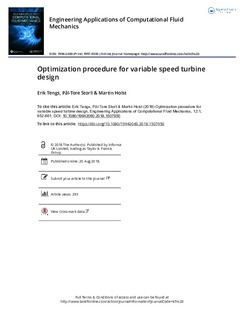| dc.contributor.author | Tengs, Erik Os | |
| dc.contributor.author | Storli, Pål-Tore Selbo | |
| dc.contributor.author | Holst, Martin | |
| dc.date.accessioned | 2019-02-22T09:54:57Z | |
| dc.date.available | 2019-02-22T09:54:57Z | |
| dc.date.created | 2018-10-01T08:55:00Z | |
| dc.date.issued | 2018 | |
| dc.identifier.citation | Engineering Applications of Computational Fluid Mechanics. 2018, 12 (1), 652-661. | nb_NO |
| dc.identifier.issn | 1994-2060 | |
| dc.identifier.uri | http://hdl.handle.net/11250/2586973 | |
| dc.description.abstract | This article outlines a design procedure for variable speed Francis turbines using optimization software. A fully parameterized turbine design procedure is implemented in MATLAB. ANSYS CFX is used to create hill diagrams for each turbine design. An operation mode of no incidence losses is chosen, and the mean efficiency in the range of the best efficiency point is used as optimization criterion. This characteristic is extracted for each design, and optiSLang is used for system coupling and optimization. In the global optimization loop, the downhill simplex method is used to maximize the turbine performance. For this article, the bounding geometry of the runner is kept as in the original configuration. This way, the performance of the different variable speed turbines can be compared directly. Two optimization parameters describing the blade leading-edge geometry have been used in the optimization procedure. The resulting design was an almost circular leading edge, and shows an increase in mean efficiency of 0.25% compared to the reference case. There was a significant change in the turbine performance, with close to no change at the best efficiency point, and an increase in efficiency of almost 1% at low rotational speed. The outlined procedure is parallelizable and can be performed within an industrial timeframe. | nb_NO |
| dc.language.iso | eng | nb_NO |
| dc.publisher | Taylor & Francis | nb_NO |
| dc.rights | Navngivelse 4.0 Internasjonal | * |
| dc.rights.uri | http://creativecommons.org/licenses/by/4.0/deed.no | * |
| dc.title | Optimization procedure for variable speed turbine design | nb_NO |
| dc.type | Journal article | nb_NO |
| dc.type | Peer reviewed | nb_NO |
| dc.description.version | publishedVersion | nb_NO |
| dc.source.pagenumber | 652-661 | nb_NO |
| dc.source.volume | 12 | nb_NO |
| dc.source.journal | Engineering Applications of Computational Fluid Mechanics | nb_NO |
| dc.source.issue | 1 | nb_NO |
| dc.identifier.doi | 10.1080/19942060.2018.1507950 | |
| dc.identifier.cristin | 1616461 | |
| dc.relation.project | Norges forskningsråd: 254987 | nb_NO |
| dc.description.localcode | © 2018 The Author(s). Published by Informa UK Limited, trading as Taylor & Francis Group. This is an Open Access article distributed under the terms of the Creative Commons Attribution License (http://creativecommons.org/licenses/by/4.0/), which permits unrestricted use, distribution, and reproduction in any medium, provided the original work is properly cited. | nb_NO |
| cristin.unitcode | 194,64,25,0 | |
| cristin.unitname | Institutt for energi- og prosessteknikk | |
| cristin.ispublished | true | |
| cristin.fulltext | original | |
| cristin.qualitycode | 1 | |

